
|
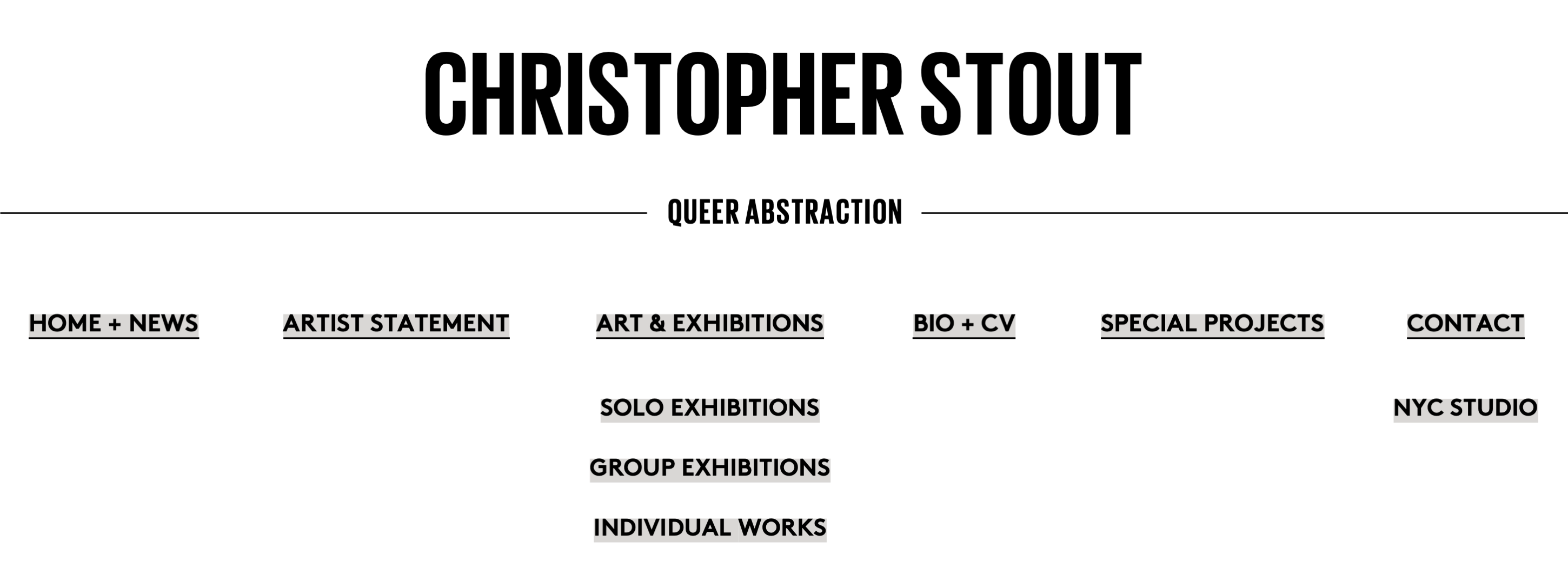
|
 |
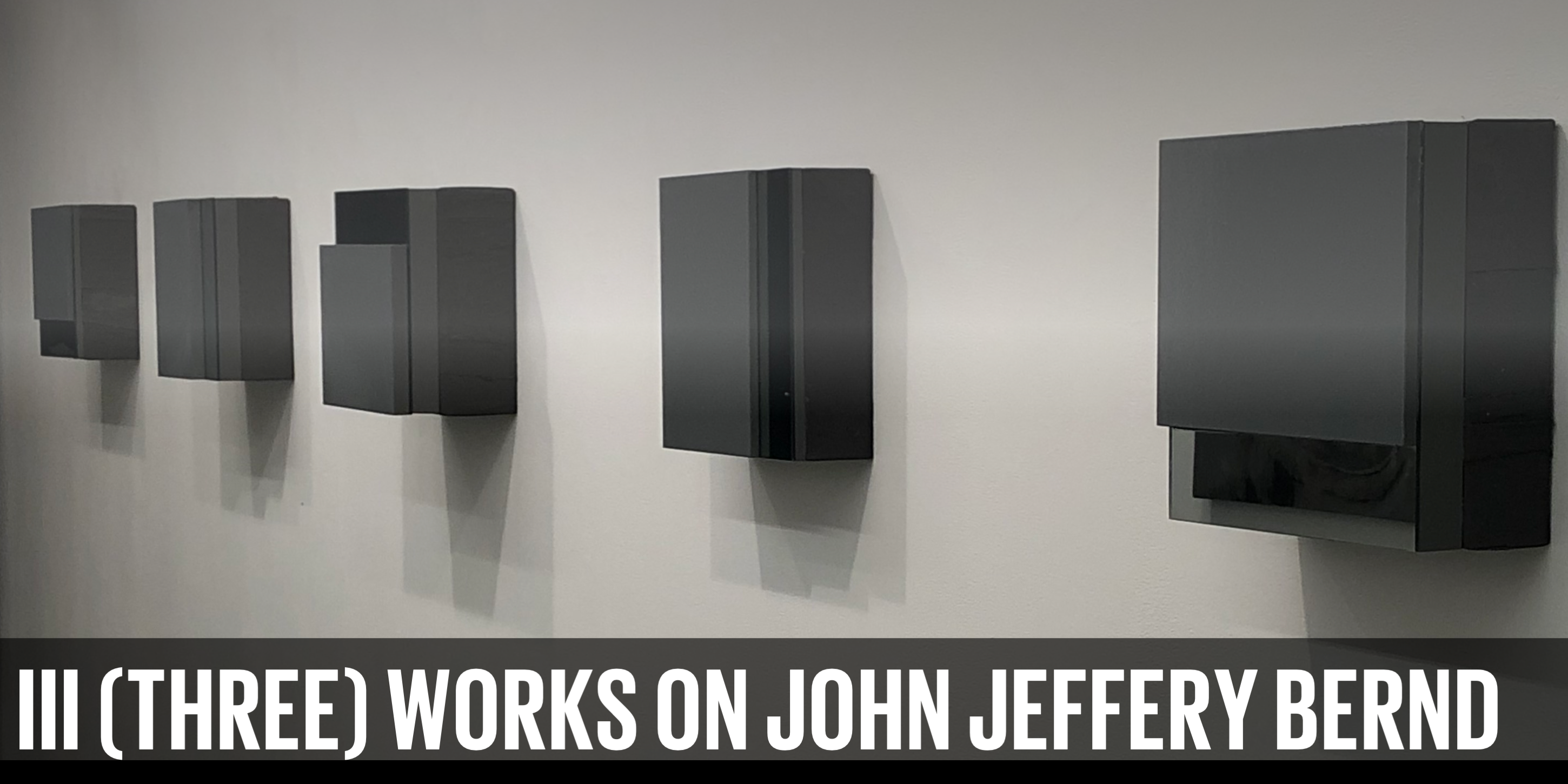 |
| |
| Caption: Installation image of this series of paintings as shown at Equity Gallery October 2021. |
| |
 |
| |
III (THREE), a reexamination of the work and queer personhood of John Jeffery Berndt
Artist
Notes (Part 1):
These 5 paintings were first shown at Equity Gallery in the Lower East Side neighborhood of Manhattan in October of 2021. Here are the research notes that I sent in preparation for the showing:
The 5 paintings that comprise III (THREE), a reexamination of the work and queer personhood of John Jeffery Bernd are series works. This manner of creative output is an intrinsic part of my artistic practice. I delight in making bodies of work with very similar physical outcomes.
As a precursor to this knowledge sharing about these paintings, we should first embark on a brief conversation about my artistic practice in queer abstraction and the definition of the term.
I am an artist who works in queer abstraction, which might be most easily understood as activist art about the queer experience that does not employ representation of the human figure. Queer abstraction, along with Black abstraction, Feminist abstraction, and even Arte Povera are 4 distinct types of sociopolitical protest work birthed in the late 1960s and early 1970s, which primarily eschew the use of figuration.
Queer abstraction has been primarily a very esoteric artform that over the last few years has suddenly begun to receive more academic focus and art world attention. Nearly every article I have read over the last several years concerning queer abstraction is prone to contextualize what queer abstraction isn’t … it isn’t informed by AIDS art generation work, it isn’t expressed by representation of the body, it does not employ the conventionally understood discourse of queer sexuality to shorthand representation of the queer experience.
Here are some timely examples of this:
https://brooklynrail.org/2017/10/artseen/Queering-Queer-Abstraction
https://www.moussemagazine.it/magazine/queer-abstraction-travis-jeppesen-2019/
http://artjournal.collegeart.org/?p=4468
These same writings are also captivated and proponents of this reclaimed activation by queer artists exhuming this rather esoteric way of making work from the late 1960’s (most often by lesbian artists) and reincarnating it to manifest conversations representing our new (art) activism. In addition, this art genre often seeks to convey and engage in the more robust telling of the abundance of queerness in in addition to the elation found within our sexual liberation.
To make this more personal, the paintings in III, a reexamination of the work and queer personhood of John Jeffery Bernd are a continuance of my investigation of enunciating, discovering, and forging relationships between queer abstraction and other genres of art made by queer artists.
With the gift of time that I (and all of us) inherited in 2020, I found myself with the ability to reflect and think about these questions. With what other types of art made by queer people would queer abstraction naturally form an alignment? Also, were there types of work made by queer people that had longstanding histories that could offer queer abstraction a halo of being easier to understand and experience?
Here are my answers to these questions:
- Writings (theory, academic, history telling) by queer authors
- Dance/movement pieces by queer choreographers and performers
- Sound art and experimental music by queer composers
(I will note that in so much as queer abstraction is viewed as a new thing or an exhumation of a previous thing, there has been a constant understood history of writing, movement, and experimental music made by queer people.)
Part two of my artist notes follows AFTER the images of these paintings. |
| |
 |
 |
|
| |
| An inventory of exhibition paintings and also the Queer academic source materials follows below: |
| |
 |
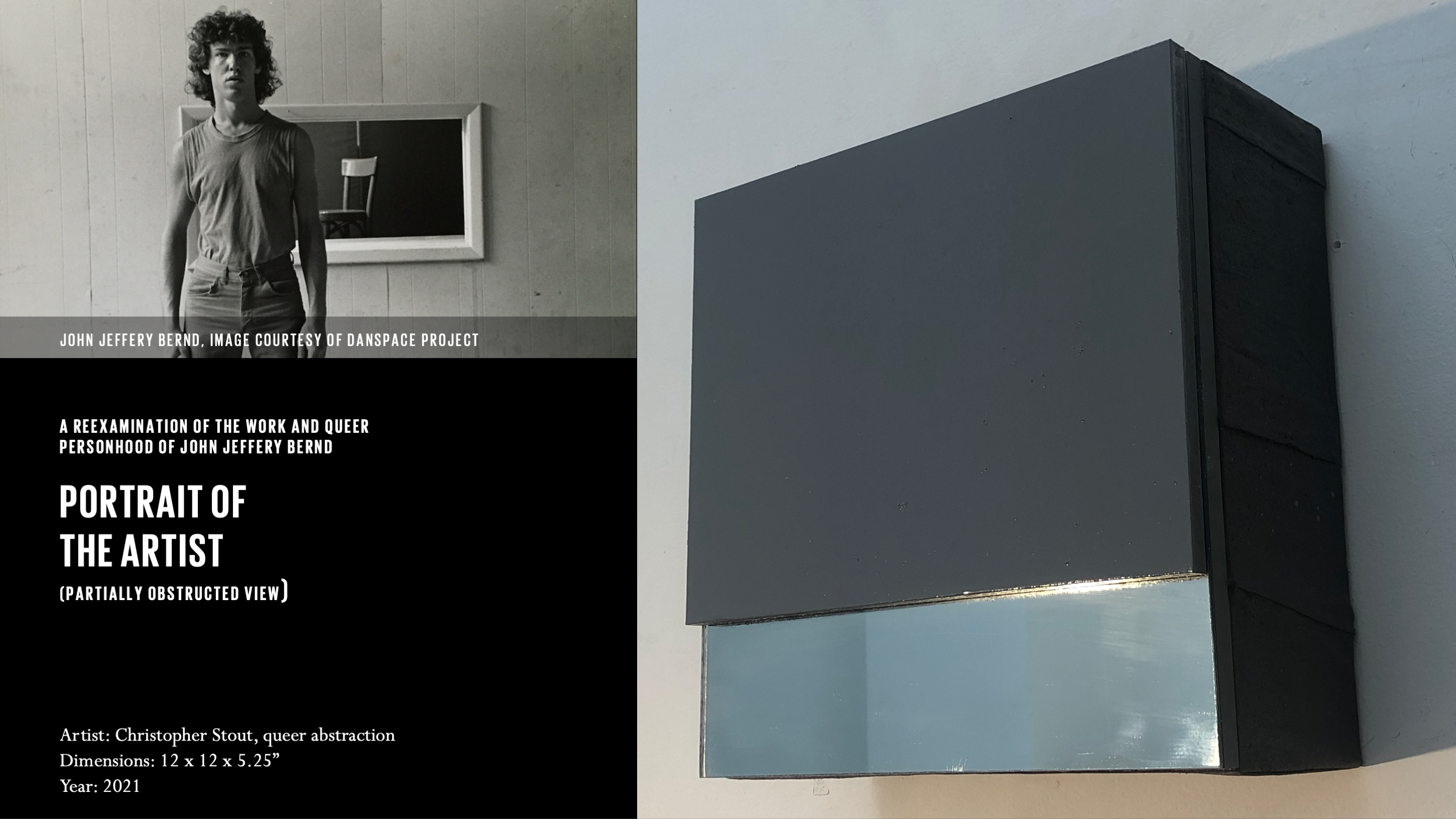 |
 |
| |
III (THREE): A reexamination of the work and queer personhood of John Jeffery Bernd
Painting 01: Portrait of the Artist (partially obstructed view)
Artist: Christopher Stout, queer abstraction
Dimensions: 12 x 12 x 5.25”
Year: 2021
Composition: Multimedia
Bottom layer: A topsoil-colored foundation painting of sewn together linen on board (refers to the history of the artist)
Layer 2: A grey painted panel to represent the flooring of a dance rehearsal space (refers to the work of dance)
Layer 3: A mirror partially allowing for representation of the viewer and partially obstructed by the top layer (refers to the viewer)
Top layer: A dark smaller grey panel to represent the flooring of a dance rehearsal space, and that allows part of the mirror to be seen and part to be obstructed. (refers to the work and the diffused relationship between this and the art and the artist) |
| |
 |
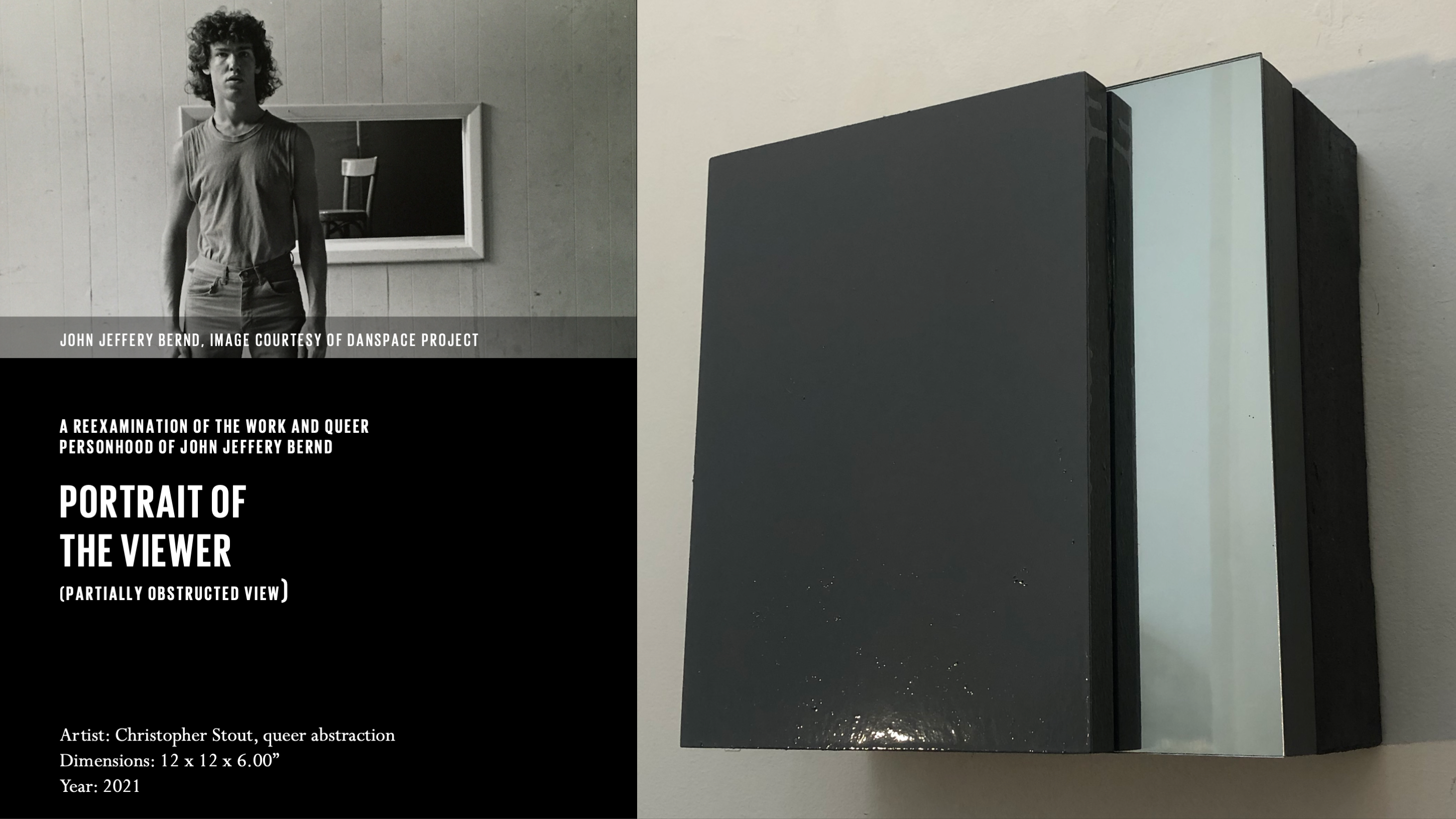 |
 |
| |
|
III (THREE): A reexamination of the work and queer personhood of John Jeffery Bernd
Painting 02: Portrait of the Viewer (partially obstructed view)
Artist: Christopher Stout, queer abstraction
Dimensions: 12 x 12 x 6.00”
Year: 2021
Composition: Multimedia
Bottom layer: A topsoil-colored foundation painting of sewn together linen on board (refers to the history of the artist)
Layer 2: A grey painted panel to represent the flooring of a dance rehearsal space (refers to the work of dance)
Layer 3: A mirror partially allowing for representation of the viewer and partially obstructed by the top layer (refers to the viewer)
Top layer: A dark smaller grey panel to represent the flooring of a dance rehearsal space, and that allows part of the mirror to be seen and part to be obstructed. (refers to the work and the diffused relationship between this and the art and the artist) |
| |
 |
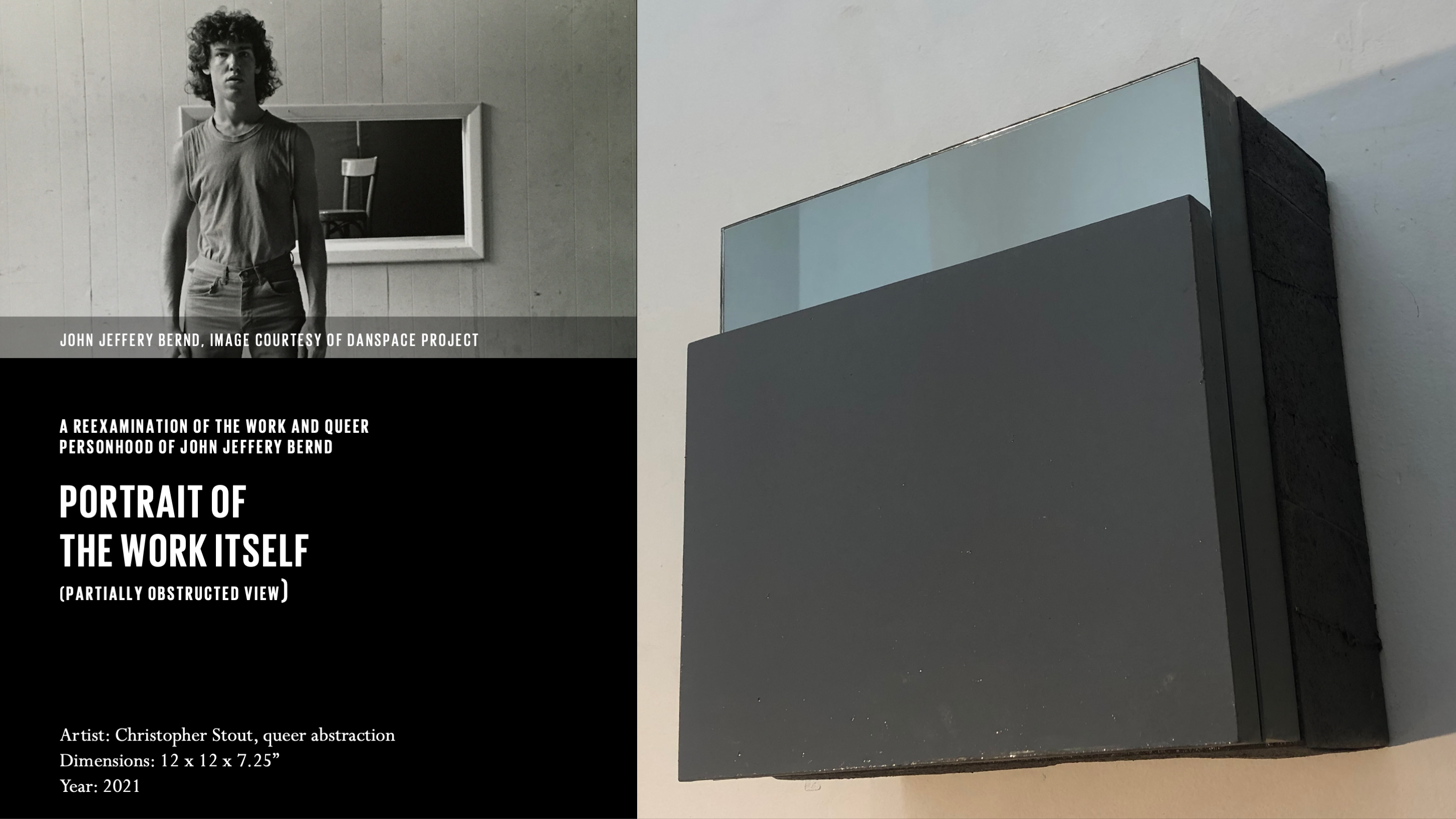 |
 |
| |
| III (THREE): A reexamination of the work and queer personhood of John Jeffery Bernd
Painting 03: Portrait of the Work Itself (partially obstructed view)
Artist: Christopher Stout, queer abstraction
Dimensions: 12 x 12 x 7.25”
Year: 2021
Composition: Multimedia
Bottom layer: A topsoil-colored foundation painting of sewn together linen on board (refers to the history of the artist)
Layer 2: A grey painted panel to represent the flooring of a dance rehearsal space (refers to the work of dance)
Layer 3: A mirror partially allowing for representation of the viewer and partially obstructed by the top layer (refers to the viewer)
Top layer: A dark smaller grey panel to represent the flooring of a dance rehearsal space, and that allows part of the mirror to be seen and part to be obstructed. (refers to the work and the diffused relationship between this and the art and the artist) |
| |
 |
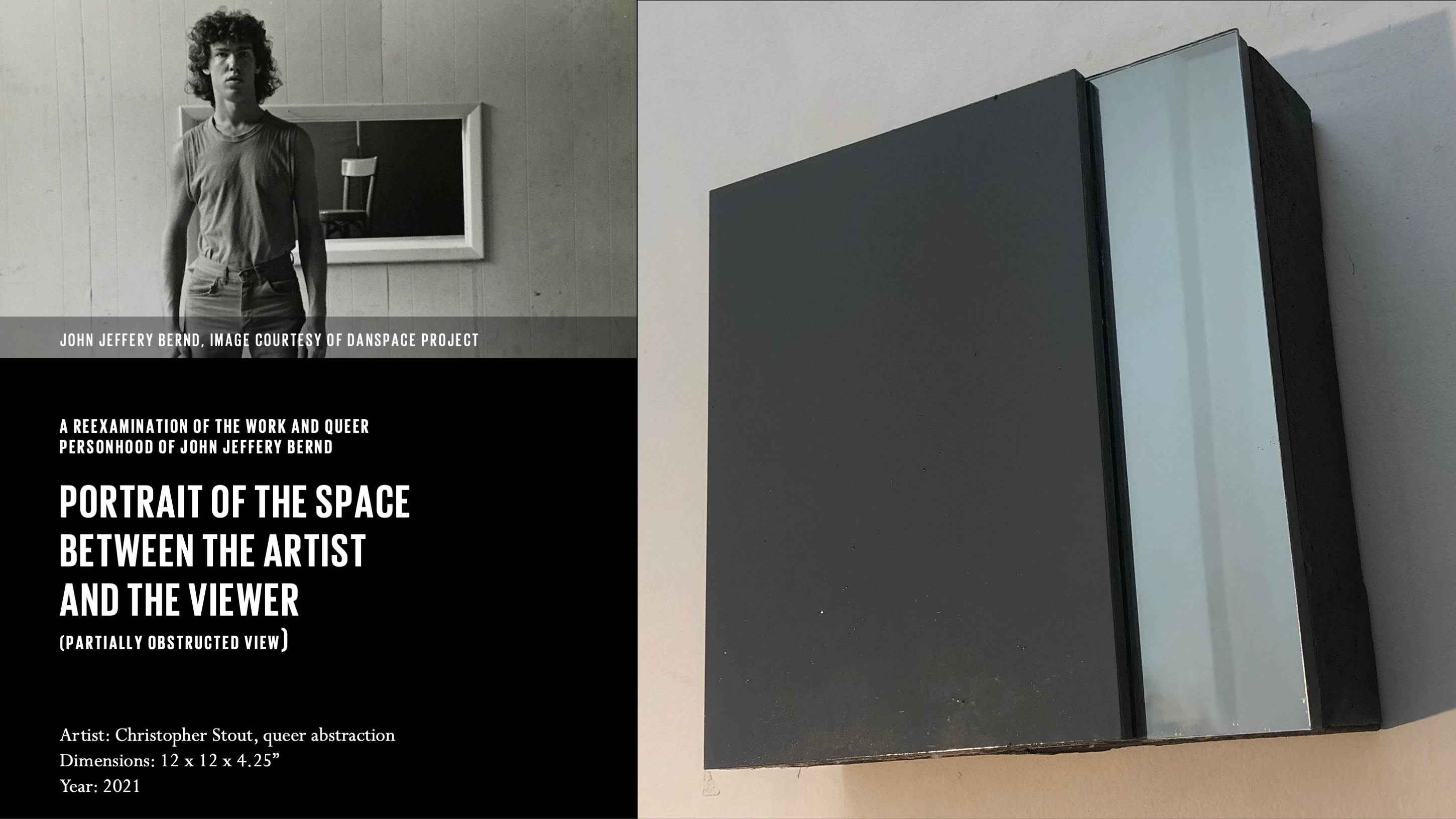 |
 |
| |
| III (THREE): A reexamination of the work and queer personhood of John Jeffery Bernd
Painting 04: Portrait of the Space Between the Artist and the Viewer (partially obstructed view)
Artist: Christopher Stout, queer abstraction
Dimensions: 12 x 12 x 4.25”
Year: 2021
Composition: Multimedia
Bottom layer: A topsoil-colored foundation painting of sewn together linen on board (refers to the history of the artist)
Layer 2: A grey painted panel to represent the flooring of a dance rehearsal space (refers to the work of dance)
Layer 3: A mirror partially allowing for representation of the viewer and partially obstructed by the top layer (refers to the viewer)
Top layer: A dark smaller grey panel to represent the flooring of a dance rehearsal space, and that allows part of the mirror to be seen and part to be obstructed. (refers to the work and the diffused relationship between this and the art and the artist) |
| |
 |
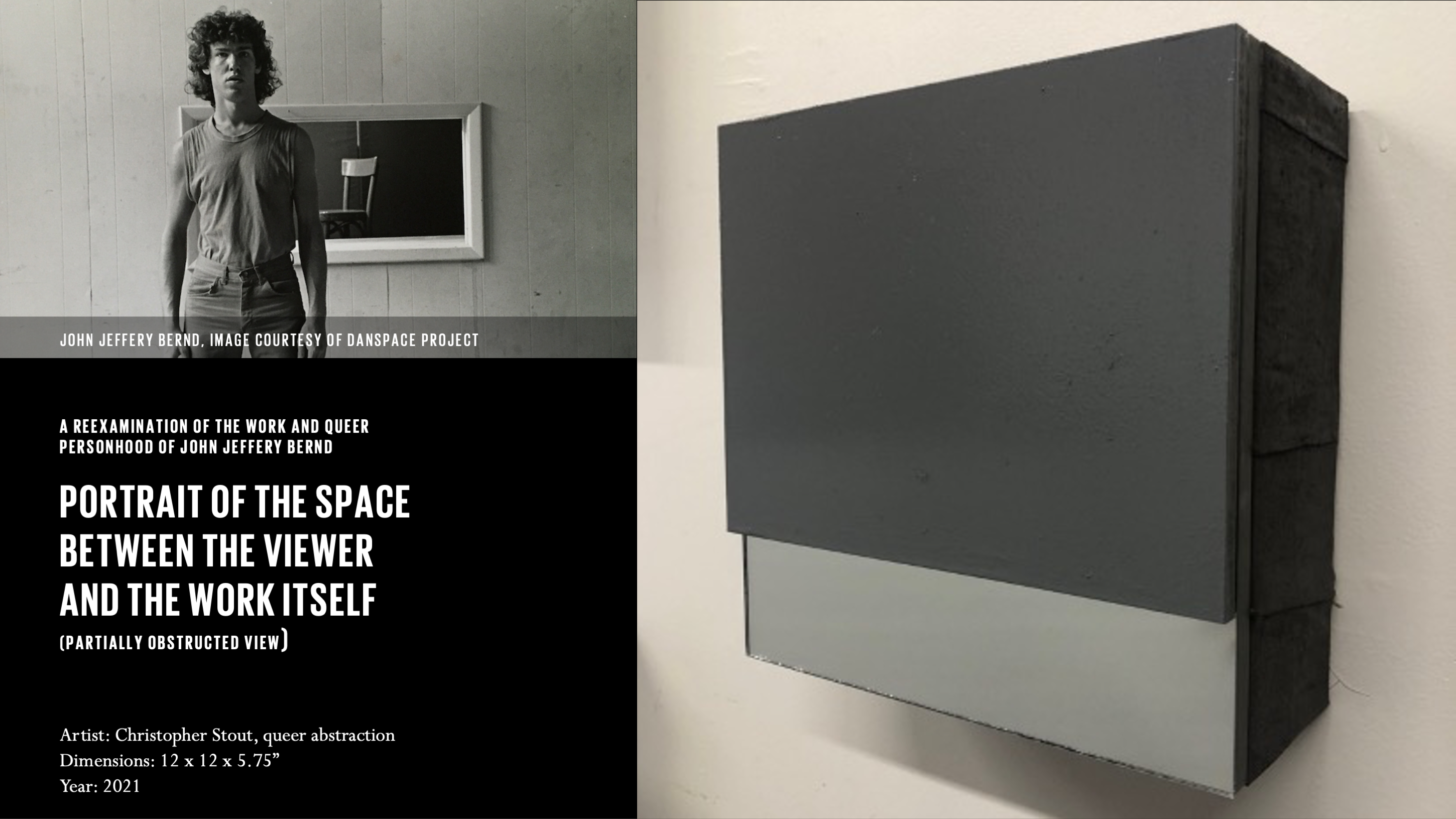 |
 |
| |
| III (THREE): A reexamination of the work and queer personhood of John Jeffery Bernd
Painting 05: Portrait of the Space Between the Viewer and the Work Itself (partially obstructed view)
Artist: Christopher Stout, queer abstraction
Dimensions: 12 x 12 x 5.75”
Year: 2021
Composition: Multimedia
Bottom layer: A topsoil-colored foundation painting of sewn together linen on board (refers to the history of the artist)
Layer 2: A grey painted panel to represent the flooring of a dance rehearsal space (refers to the work of dance)
Layer 3: A mirror partially allowing for representation of the viewer and partially obstructed by the top layer (refers to the viewer)
Top layer: A dark smaller grey panel to represent the flooring of a dance rehearsal space, and that allows part of the mirror to be seen and part to be obstructed. (refers to the work and the diffused relationship between this and the art and the artist) |
| |
 |
| |
III (THREE), a reexamination of the work and queer personhood of John Jeffery Berndt
Artist
Notes (Part 2 continued from above):
With these things in mind, during 2021, I have released 3 small sets of new works.
In April 2021, I released a set of 9 monochrome drawings in which each drawing was made whilst listening to the work of a queer composer. (9 drawings from 9 songs by 9 queer composers)
http://christopherstout.com/art-chosen-family-artfare.html
In September 2021, I released a set of 8 paintings in which each painting was made after reading the work of a queer academic writer (8 paintings from 8 theory books by 8 queer authors)
http://christopherstout.com/art-wonderment-of-otherness.html
This new set of 5 paintings was made to reflect upon the work of queer choreographer John Jeffery Bernd (1953–1988) who died of AIDS. Here are some background links:
https://visualaids.org/artists/john-bernd
https://www.nytimes.com/1988/09/01/obituaries/john-jeffery-bernd-35-an-innovator-in-dance.html
An important note that I am certainly not the first artist to recently make work respecting the work of John Jeffery Bernd:
Example link: https://philadelphiadance.org/dancejournal/2018/09/10/exploring-dance-artistry-of-john-bernd-with-ishmael-houston-jones-miguel-gutierrez/
John graduated from Antioch College in the 1970's, which is a social justice college in Yellow Springs Ohio, and moved to New York City where he became an arterial member of the downtown experimental dance scene.
Today, John is memorialized as part of the “first wave” of creative downtown New Yorkers caught unawares and struck down by AIDS in the height of their careers. To that end, the work that John is specifically acclaimed for, are pieces such as Surviving Love and Death, (1981) which addressed his illness.
While I certainly can’t disassociate these new paintings from any of the biographical information on Bernd that I have shared, I am rather hoping to utilize this work to hone a conversation the things John’s work concerned itself with before AIDS became his (necessarily) activist overshadowing focus.
I would submit that the paintings in III, a reexamination of the work and queer personhood of John Jeffery Bernd reconnect with Bernd’s pre-AIDS overarching fascination with the relationship between art, and the artist, and the viewer.
With a view to accomplish this, I have made the following designations:
The artist: John Jeffery Bernd, dancer, experimentalist choreographer, associate director of Performance Space 122, recipient of a Bessie, the New York Dance and Performance Award
The art: All of the work of John Bernd: at Antioch, in New York City and elsewhere, pre- and during his AIDS diagnosis
The viewer: All of us, past and present who are or should be nurtured by his work
The 5 paintings in my show follow the same cadence:
Bottom layer: A topsoil-colored foundation painting of sewn together linen on board (refers to the history of the artist)
Layer 2: A grey painted panel to represent the flooring of a dance rehearsal space (refers to the work of dance)
Layer 3: A mirror partially allowing for representation of the viewer and partially obstructed by the top layer (refers to the viewer)
Top layer: A dark smaller grey panel to represent the flooring of a dance rehearsal space, and that allows part of the mirror to be seen and part to be obstructed. (refers to the work and the diffused relationship between this and the art and the artist)
Thank you for this opportunity of sharing this work and about the life and art of John Jeffery Bernd with you. |
| |
 |
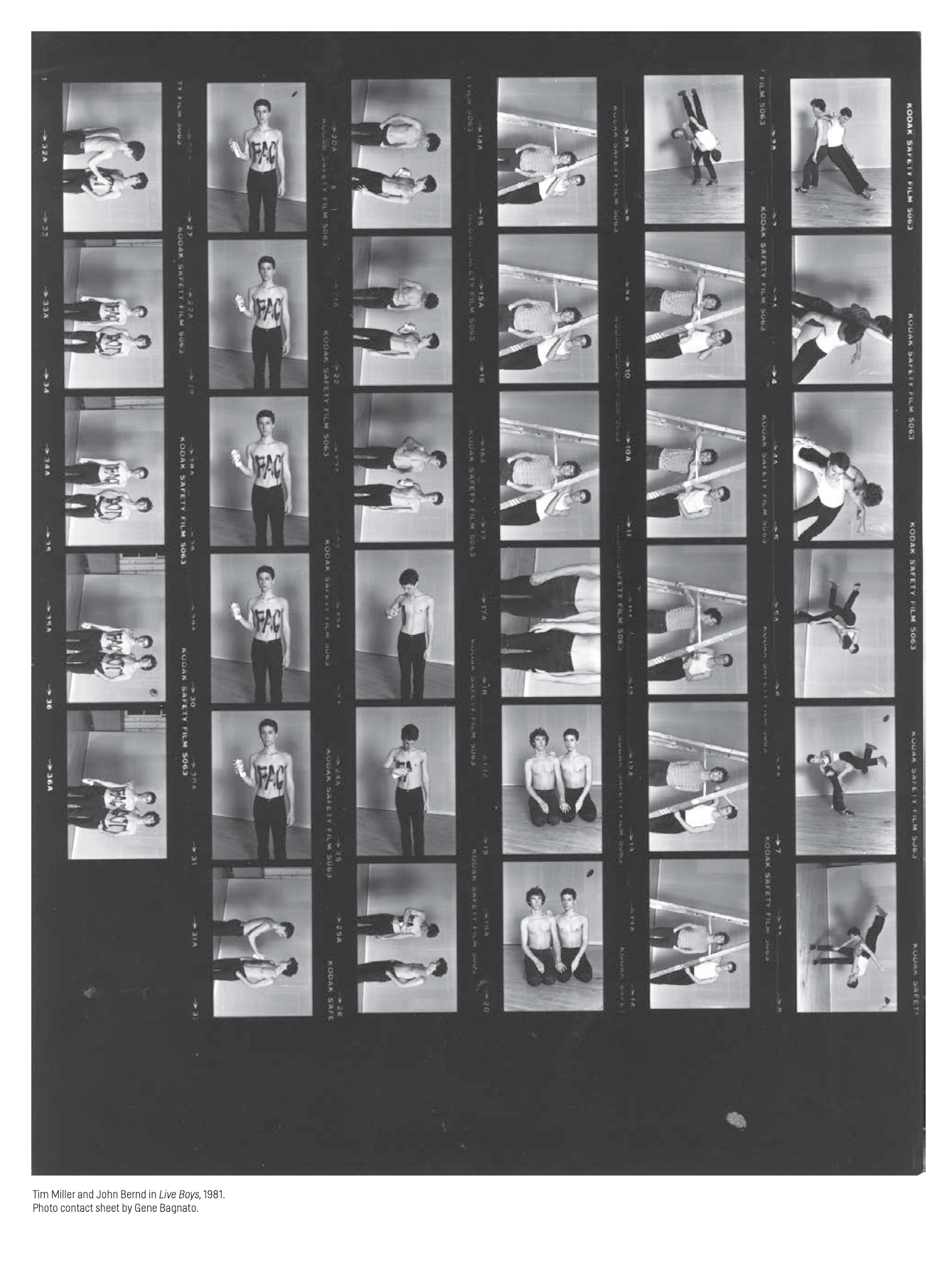 |
 |
| |
| Caption: Page 38 of the book Lost and Found, Dance, New York, HIV/AIDS, Then and Now and published in 2016 by the Danspace Project, showing a contact sheet from the performance Live Boys (1981) by Tim Miller and John Bernd. The original contanct sheet was taken by Gene Bagnato. |
| |
 |
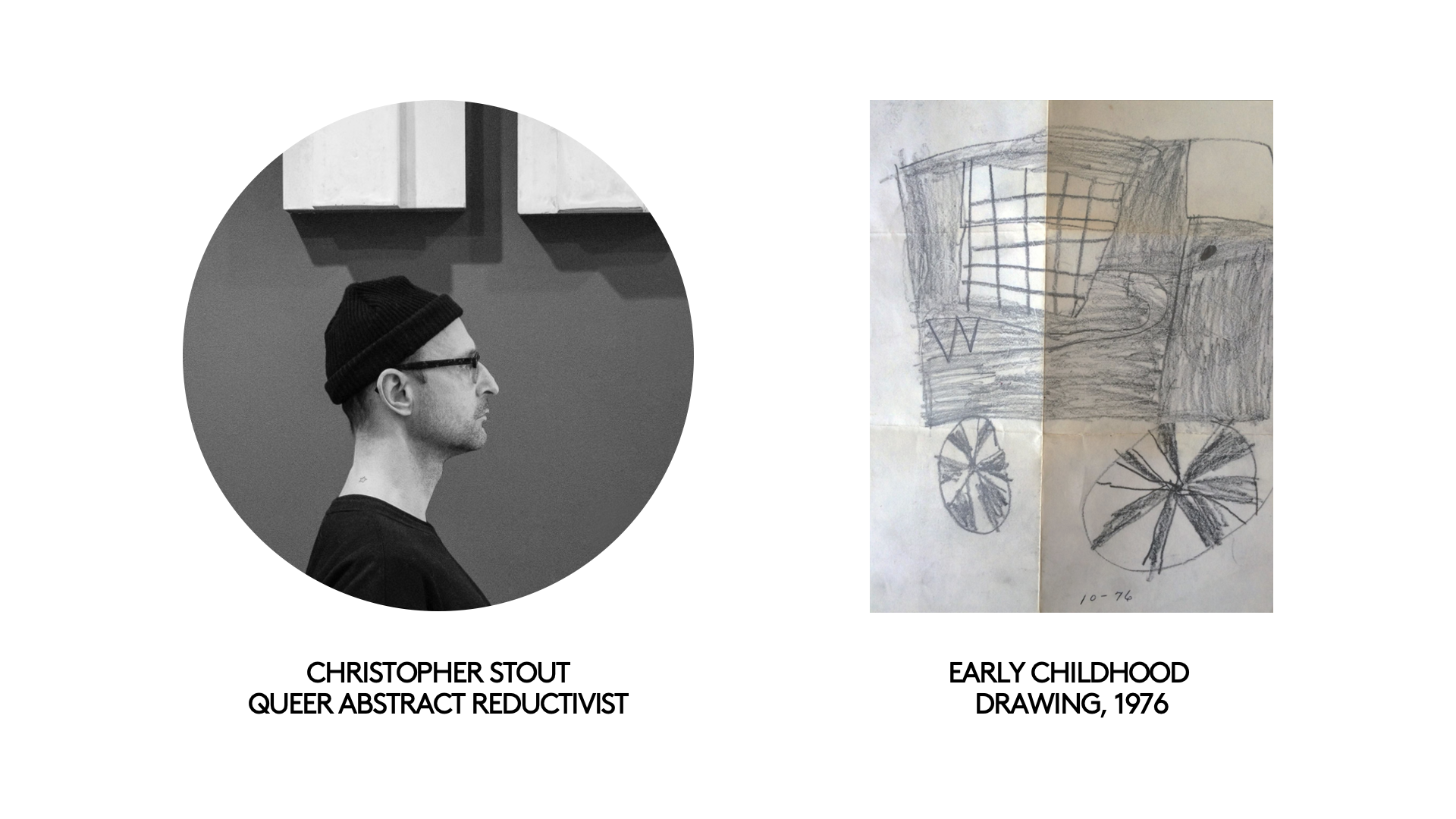 |
| |
 |
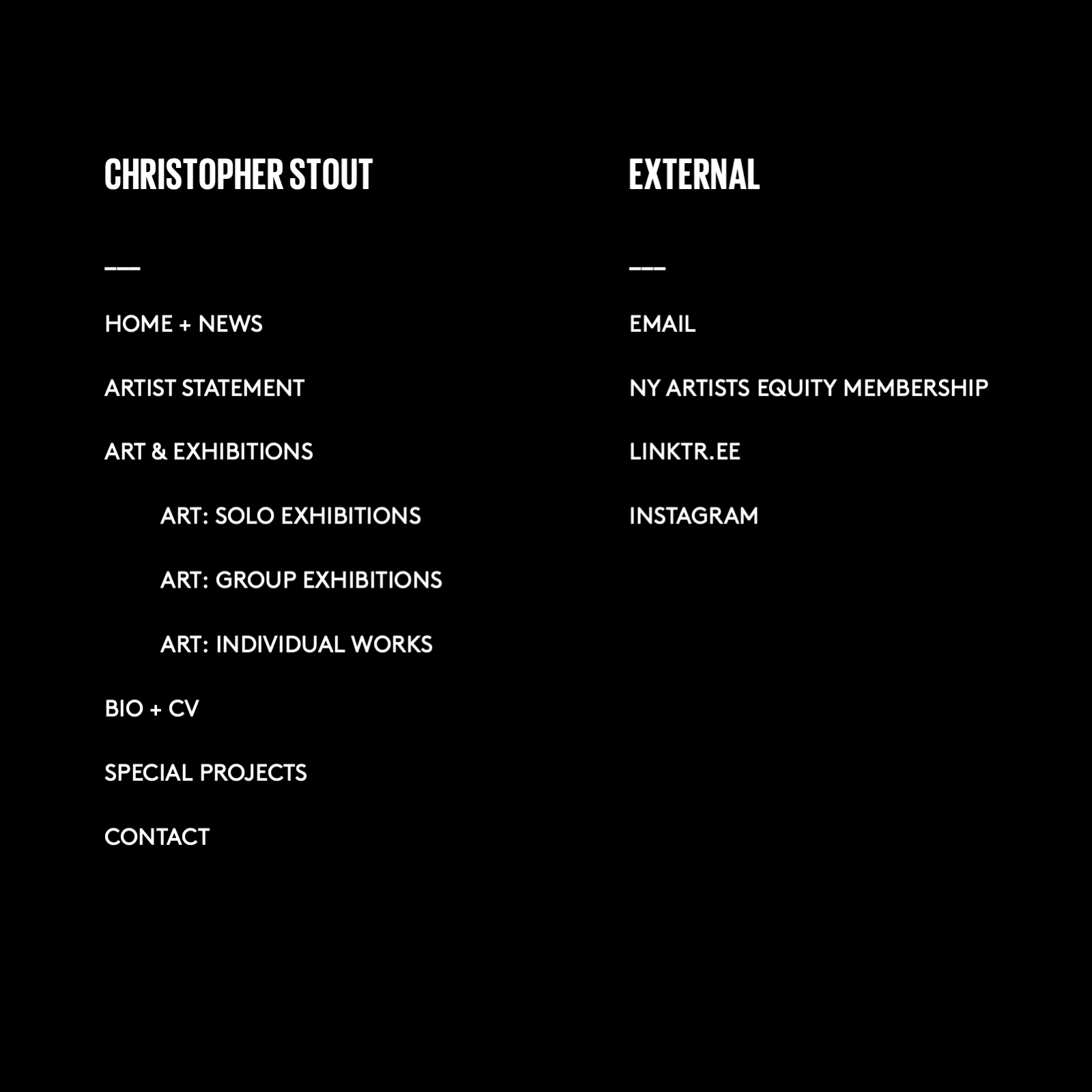
|
 |
| |












